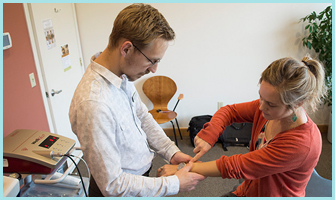About Acoustic Compression
Watch our seminar on Acoustic Compression
How does it work?
Acoustic Compression works by creating a brief pulse of sound traveling at supersonic speeds. When these pulses are directed into the body, the sound waves become compressed and create a small sonic boom within the tissue. This sonic boom is safe and harmless; however, it stimulates nearby cells to send out a distress signal to the body as though a new injury has occurred, causing the body to focus on healing the area. The therapist directs these acoustic impulses very specifically into areas of the body with pain, inflammation, scar tissue, trigger points, or other dysfunctions. The body then responds by breaking up scar tissue, increasing blood flow to the area, increasing the energy output and division of surrounding cells, and recruiting immune cells which help regulate inflammation. Eventually, there is even an increase in active stem cells in the area, helping to promote healing in a very profound and complete way.
Acoustic Compression causes the body to pay attention to a part of the body that needs healing – greatly accelerating the healing time of injuries, and reversing the degenerative processes of chronic conditions. This healing effect makes Acoustic Compression a very effective therapy for a wide variety of circumstances. Sudden sports injures such as sprains, strains, meniscus tears, labral tears and stress fractures heal much more quickly and completely if Acoustic Compression is used on the area, especially if treated soon after the injury. It can also be used post-surgically, accelerating the rate of postoperative healing and improving the long-term outcomes of surgical procedures. Repetitive stress injuries like tennis elbow, carpal tunnel syndrome, frozen shoulder, bursitis and plantar fasciitis begin to heal again, even if the area has had trouble for a long time. We have also seen great success with chronic troubles such as low back pain, arthritis, joint degeneration, varicose veins and osteoporosis, helping the body to break its patterns of degeneration, pain, or inflammation and get back on the path of healing once again.
Healing is our passion here at DBC. We are constantly thrilled and amazed to see the incredible improvements our patients have experienced by using Acoustic Compression therapy – whether it be the athlete back in the game weeks ahead of schedule, the chronic pain patient able to get up without pain for the first time in decades, or the office worker freed from a troubling case of carpal tunnel syndrome.
If you're already a patient at DBC, talk to your DBC doctor today to see if Acoustic Compression can help your condition! If you haven't visited us yet, the new patients section will guide you through the process. We hope to see you soon!
"Acoustic Compression causes
the body to pay attention the part
of body that needs healing"

If you have more questions about Acoustic Compression, or just would like to learn more, check out our FAQ page.
In much of the scientific literature, and many other places on the web, Acoustic Compression is called Extracorporeal Shock Wave Therapy, often abbreviated to EWST. (We prefer Acoustic Compression as we feel it is more clear and less of a mouthful.)
For those interested in the scientific research and trials proving the efficacy of Acoustic Compression,
check out some of the resources on the National Center for Biotechnology Information website.
Acoustic Compression is often mistaken for Ultrasound therapy. However, though both therapies work by directing sound waves into the body, Ultrasound works by creating a vibration in the tissue rather than a shockwave. Though perhaps slightly effective at promoting healing in treatment areas, we feel this technology is far less effective than the newer Acoustic Compression therapy, which consistently creates dramatic and long-term healing effects
in the treated area.
Cold Laser therapy is another newer therapy that uses focused light rather than sound waves to direct energy into the body. Like Acoustic Compression, it can effectively drive healing and recovery and regulate inflammation in a treatment area; in fact, we looked closely at using Cold Laser therapy before settling on Acoustic Compression. However, we feel the effects are not quite as powerful as those we get from Acoustic Compression therapy, nor is it possible to affect as many different areas. Additionally, Cold Laser therapy generally takes significantly more and more frequent treatment sessions to see results. Though we are willing to do anything it takes to provide our patients the best care possible, we like to do so with as little strain upon your time and resources as possible! In the end, Cold Laser, though an excellent therapy, simply did not seem to be either as effective or as efficient as Acoustic Compression therapy.


